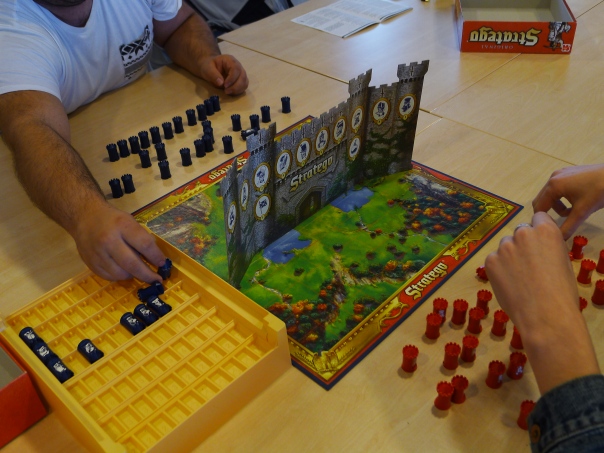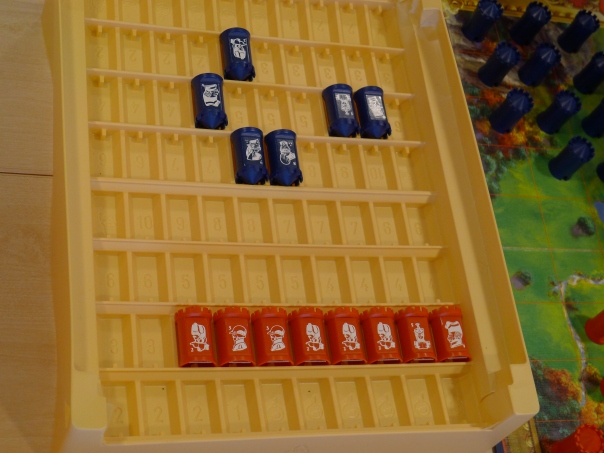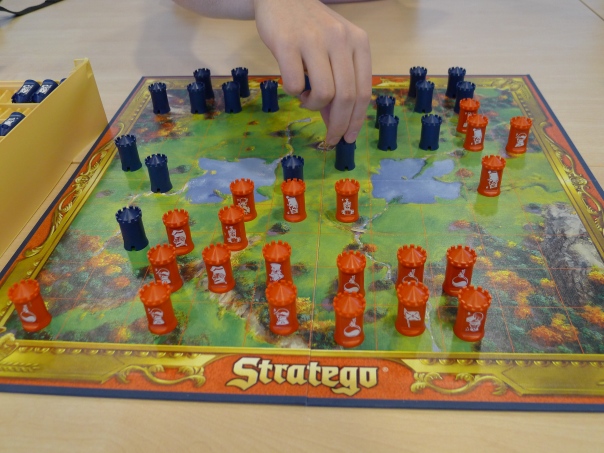So here we go! Second board game analysis. Stratego.
For our second board game we chose Stratego, a strategy game with strong focus on memory, tactics and deception. After some research it seems that it was the so called official modern version , it uses the original rules with two players and the ranks of the pieces are counted upwards (1 is the least powerful piece and 10 is the most as opposed to the American version where 1 is most powerful and 10 least). There seems to exist 4 player versions of the game and certain versions with more different kinds of pieces.
The game is played on a 100 square board with two players controlling 40 game pieces each. These include troops a banner and a number of bombs.
Every “troop” piece has a point value ranging from 1 to 10 and a military rank ranging from marshal (10 points) to spy (1 point). Every troop piece can move a single space vertically or horizontally, but not diagonally with one exception.
The scout pieces (2 points) can move in a straight line as far as the way is clear and even attack enemies in this manner, they can still not move diagonally though.
The other troops with special rules are the spy. Each player has a single 1 point solider that is killed by all other troop except for one thing, it can kill the opponents marshal (rank 10) piece if it attacks, making it quite valuable despite its weakness.
The last special troop is the sapper, also called miner in some versions (3 points) who are the only troop type that can win against the bomb pieces; all other pieces attacking a bomb piece are immediately destroyed.
And speak of the devil there are two kinds of immobile pieces in this game, bombs and the banner. Bombs cannot be defeated unless attacked by a sapper. The flag is the most important piece on the board, since if your opponent attacks your flag you have lost.
On the board layout there is not that much to say except that in the middle of the board there are two lakes taking up 2×2 squares each, effectively making three 2×2 corridors where the opening fights will take place.
So at the start of the game a screen is set up in the middle of the board and the two players start the setup phase. They have to set up all their pieces on the closest four rows of the board with the point values facing themselves. In this way when the screen is removed the players won’t have any idea as to their enemies’ troop setup.
Once setup is finished the screen is removed and the red player makes the first move, moving one troop piece, then it is the blue player turn and so on, the players may not place a piece on a square already occupied by a friendly piece. And if a player tries to move into a square occupied by one of the opponent’s pieces battle is joined. The attacking player taps the enemy piece lightly with their piece and tells them the point value of the attacking piece, whereupon the other player tells the point value of their piece. The piece with the lower value is killed and placed back in its marked slot in the storage rack (the yellow thing on the picture bellow) thus both players have quick overview of what troops their enemy have left on the board.
I am now leaving you with a table of units and descriptions shamelessly quoted from Wikipedia. (http://en.wikipedia.org/wiki/Stratego#Classic_version)
“
| Rank # | Piece | Number available | Special Abilities |
| 10 or 1 | Marshal | 1 | |
| 9 or 2 | General | 1 | |
| 8 or 3 | Colonel | 2 | |
| 7 or 4 | Major | 3 | |
| 6 or 5 | Captain | 4 | |
| 5 or 6 | Lieutenant | 4 | |
| 4 or 7 | Sergeant | 4 | |
| 3 or 8 | Miner / Sapper | 5 | Can defuse bombs |
| 2 or 9 | Scout | 8 | Can move any distance in a straight line |
| 1 or S | Spy | 1 | Can defeat the Marshal, but only if the Spy makes the attack |
| B | Bomb | 6 | Immovable; destroys any attacking piece except Miner |
| F | Flag | 1 | Immovable; its capture ends the game |
“
If the attacking player wins their piece takes the place of the defeated enemy but if the defender win no pieces are moved, the attacking piece is just destroyed. If both pieces have the same point value they are both destroyed.
If a player finds the enemy flag they win and if a player loses all their troops they lose (not counting bombs and the flag).
Best parts
Since the players set up their pieces themselves there is great diversity between player an even between matches between the same players. There is also the fact that the enemy pieces are hidden thus adding a layer of deception and memory games to the pile. Allowing for bluffs by charging high value enemies with low value ones or not moving troops and pretending that they are bombs.
The original are few rules and there are few special rules for the different troop types, making it a lot easier for first time players that some other variants of the game.
Also the weakest troops all have special rules to make them relevant in the fighting, having a scout or two left in late game when you have figured out where the enemy spy is can be a great help because of their mobility.
Likewise having sappers (or miners) is often a requirement to getting to your opponent’s flag since it is often surrounded by bombs.
Also, having more than one winning condition stops the game from getting into stalemates and there is a rule against moving a piece back and forth between two squares for extended times.
Worst parts
Once again one of the worst parts of the game is that the time it takes to play it is rather unpredictable we played one game lasting less than 20 minutes, setup included and one that went on for about 1 hour and 45 minutes. Also the box was much bigger than it needed to be, 3 to 4 times deeper which seemed kind of pointless to me but I guess they wanted their game to seem grander.
Also the version we had only supported 2 players. This lead to the non-playing group members (me included) sometimes getting little a bit restless during the longer games. Though it should be added that while doing some research on the internet I read that there are at least one version of the game that is made for 4 players.
The game also feels a bit daunting when you first see it, lots of little pieces with different pictures on it and a memory game on top of that.
Most interesting system and personal thoughts
I would say that the most interesting system would clearly be the fact that you can’t see the enemy pieces and that the only way you can find out is to attack them. This leads to some truly wonderful bluffs and disorientation when you can no longer remember which enemy pieces have moved, which piece was the marshal or general and so on.
This together with the free setup and need to pack your soldiers tight into a 4×10 box in the beginning of the game makes for some truly great gameplay. For instance if your opponents marshal is revealed and starts wreaking havoc you can sometimes scare them away by making a path for a piece from the middle of the board which they then believe is your spy. It may however be just any sort of troop and your spy might be locked away on the other end of the board, or your spy might be lying in ambush mush closer.
I found this game really enjoyable, the mind games and crazy intimidation tactics especially entertaining. I really feel that this is a game I should add to my personal collection sometime.
Target group interpretation
Let’s start with the box numbers again. The numbers say 8+ and I think this is quite like Carcassonne in the way that you can play it at that age but I think that the ones that would appreciate it most are a little bit older, perhaps 14+ or some such number.
The box art on our version (I think it was the same, I googled it and found the one I think we had) features three cavalrymen one cuirassier wielding a sabre, one light cavalryman (probably a dragoon or hussar or Cossack irregular) and one unarmoured horseman with a lance (ulan I think) riding dramatically with two flags in the background. This speaks of action and courage. Once again a little bit misleading since the game is more about careful consideration, planning and bluffing.
I would guess that the box art speaks to young boys pretty well and that the ages 8+ might not be so bad an estimate as to who might want to pick it up, it looks a bit “mature” so the kids that want to grow up fast are going to dive real hard for it. Also anything with swords and lances usually goes home with young boys and to a lesser extent girl, if me and my friends back in the day are any measure.
There are however other releases of the game with more subdued box art, for instance one where an old man in a military uniform is sitting and playing the game.
So to sum that up I think that the game is marketed towards males in their earliest teens, at least the release we had on our hands.
Summary
Stratego is a strategy board game about tactics, strategy, memory and bluffing. Two players fight a battle using pieces with hidden values and their own setup as they try to find one specific of the opponents 7 unmovable pieces or kill all their opponents’ mobile troops.
The game is different every match and every player makes their own strategies. The hidden troop values and massive amount of troops can seem a bit scary at first but it is quite alright because there are quite few rules, and very few special rules for individual troop types.
The game can take anything from 20 minutes to almost 2 hours to play and I would say this is the games’ greatest drawback.
I really enjoyed it but I can see that it might be a bit too much for some people, if you like bluffing and strategy games however this is a very good choise.
//Max Norldund


